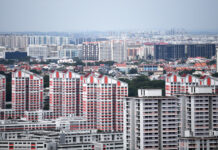SINGAPORE: When the global financial crisis hit Singapore in 2009, the shock left the country with real GDP growth of 0.1 per cent.
But the economy rebounded quickly. The following nine years delivered an average annual growth of 5.2 per cent, owing largely to a sharp rebound in 2010, registering a growth of 14.5 per cent.
The mood is discernibly more downbeat this time. With estimates showing that Singapore’s GDP grew by 0.7 per cent in 2019, the Government now forecasts that the economy will grow only within the range of 0.5 to 2.5 per cent in 2020.
Is low growth the new normal for Singapore?
As a small, open economy heavily dependent on external demand, Singapore’s national output is subject to the vagaries of the global economy. The negative impact of the global financial crisis was transmitted mainly through a sharp decline in the republic’s net exports.
By the same token, the sharp rebound in 2010 came primarily through an expansion of net exports. The question is whether we can expect a similar recovery in the next couple of years.
READ: Commentary: The Singapore economy in 2020 – stabilisation or more uncertainties?
READ: Commentary: The brewing discontent with trade and one step to restoring faith in globalisation
US-CHINA TRADE WAR PRESENTS STRONG HEADWINDS
One reason to think we are less likely to see a strong recovery this time around is that the US-China trade war is affecting the Singapore economy by disrupting global supply chains.
With deep integration into the international production network being the country’s lifeblood, even tariff barriers elsewhere present strong headwinds for our economy.
Higher tariffs on Chinese goods, for example, result in diminished demand for Singapore’s exports of intermediate products to China and other importing nations that are part of the global value chain.
Global trade growth has slowed in 2019 according to the WTO. (File photo: AFP/Roslan Rahman)
READ: Commentary: The end of the decade – the world is in more debt and it isn’t going away
The implications could move beyond trade into the reshaping of global production lines, if distrust seeps into technology and other sectors that deal with critical infrastructure with potential national security implications.
Looking ahead, growth accounting provides a way for us to think about how Singapore’s economic growth can continue to keep up.
The growth of Singapore’s total real GDP today depends on labour force growth, capital investment, and growth of total factor productivity.
DECLINING CITIZEN WORKFORCE
Singapore’s total labour force, made up of residents and foreigners, grew on average by 2.2 per cent over the period 2010 to 2018. Growth in labour inputs contributed to nearly a quarter of the GDP growth, with technology, capital and productivity gains making up the rest.
According to Singapore’s Population White Paper, the number of citizens in the working ages of 20 to 64 years will start to decline from this year onwards due to more retiring and fewer entering the workforce, as the number of babies dropped to an eight-year low in 2019.
This factor, taken alone, will be a drag on growth.
READ: Commentary: Have we placed too much faith in science to solve all our fertility problems?
While raising the retirement age, and boosting the labour force participation rate, particularly of women, can attenuate this drag to some extent, it is unlikely to be enough to substantially increase the total number of hours worked or even maintain current levels.
The case of Japan is instructive. Over the period 2010 to 2018, the average annual growth of Japan’s real GDP was 1.4 per cent.
The decline in the Japanese working-age population is, no doubt, a factor contributing to its anaemic growth, with the IMF calculating the impact of ageing could drag down GDP growth by 1 percentage point over the next three decades.
For Singapore, a combination of policy efforts to boost the total fertility rate as well as to relook immigration seems inevitable if we are to avoid a labour crunch leading to a growth drag.
READ: Commentary: Despite achieving economic success, Japan struggles with gender gap
Workers cross the road in the central business district of Singapore. (File photo: AFP/Simin Wang)
MAINTAINING A HIGH INVESTMENT RATE
Quite remarkably, the share of investment in GDP has averaged 27.2 per cent over the period 2010 to 2018, a portion of which is in the form of inward foreign direct investment.
Public investment in infrastructure, including the building of several MRT lines and construction of huge projects such as Jewel Changi Airport, also contributed to the internationally high investment rate, compared to the median of about 20 per cent according to World Bank 2018 figures.
Growth of capital input contributes to about two-thirds of GDP growth.
Singapore’s reputation as a reliable destination for foreign direct investment built up over several decades, no doubt, contributes to its ability to attract multinational corporations to place a segment of their manufacturing process, which will require a number of years for costs to be recovered, here.
Its strong institutions, supported by secure property rights and a sound legal system, is a comparative advantage. An education system responsive to market needs in supplying workers with the relevant skills has also served us well.
Semiconductors giant Micron, for instance, announced it plans to invest billions more and add 1,500 more jobs over the next five years at the opening of its expanded facility in Singapore in August 2019.
However, with advances in information and communications technology and artificial intelligence making it possible for foreign firms to employ workers to perform many tasks remotely, Singapore will face greater challenges in attracting foreign direct investment.
READ: Commentary: Seniors do well at their jobs yet ageist myths and negative stereotypes persist
File photo of an office employee.
Singaporeans will also have to adapt to this changing nature of work, and undergo the necessary training to gain relevant skills but this is not an easy ask for older workers in their 50s and 60s.
A shrinking citizen workforce will also reduce the talent pool that Singapore can offer, which could sway the calculations of multinationals deciding whether to locate their facilities here.
READ: Commentary: The future is tech but where is Singapore’s engineering and IT talent?
CREATING INDIGENOUS INNOVATION
Since capital investment ultimately faces diminishing returns, the source of sustained growth comes from indigenous innovation.
When the technology gap was huge, Singapore’s ability to attract multinational corporations that brought the technological knowhow contributed to its GDP growth. With a narrower technology gap now, Singapore has to expand its own capacity to innovate.
The shift in the education system to inculcate innovativeness and encourage risk-taking, through initiatives such as the Applied Learning Programmes, will help to increase the supply of innovators.
Strengthening the eco-system to encourage new start-ups and growing the venture capital industry are all necessary moves to foster innovation and thus generate growth in total factor productivity.
In recent years, the Government has placed more emphasis on nurturing start-ups, through the creation of various grants, loans and co-investment funds investing in accelerators and Singapore-based companies with high growth potential, and the creation of SGInnovate, an organisation dedicated to helping deep tech start-ups grow.
The Government has also continued to place emphasis on building up enterprise research, with over S$19 billion committed under the Research, Innovation and Enterprise 2020 plan.
The new anti-cancer drug was developed by Assoc Prof Giorgia Pastorin, Assoc Prof Ang Wee Han and Dr Maria Babak. (Photo: National University of Singapore)
These efforts, however, will take time to bear fruit. For the period 2010 to 2018, growth in total factor productivity contributed to less than 10 per cent of GDP growth.
IS THERE A CASE FOR OPTIMISM?
A shrinking citizen workforce, the law of diminishing returns to capital, and the time needed to bring about a culture shift towards indigenous innovation all portend low growth for Singapore. Is there any reason to remain optimistic?
The answer is yes. Singapore has been able to achieve domestic social and political consensus to reinvent itself to ride on opportunities thrown up by the global economy, and find new ways of overcoming our constraints.
When it faced a severe recession in 1985, caused in part by wages running ahead of productivity, workers accepted a 15-percentage point cut in employers’ CPF contribution rate, which was gradually restored.
Having recovered, workers’ skills were developed to take advantage of the growing financial sector fuelled by funds flowing into a booming region from 1989 to 1998.
Through government initiatives announced over recent Singapore Budgets, firms have also been encouraged to embrace automation, digitalisation and reskilling, and rely less on foreign labour in a manpower-lean economy.
Finance Minister Heng Swee Keat delivers the Budget 2019 statement on Feb 19, 2019.
More recently, bold plans for the Greater Southern Waterfront after the ports are relocated away from Tanjong Pagar to free up valuable land to be redeveloped in the downtown region were announced just last year.
So Singapore can surely find the necessary gumption to reinvent itself again and overcome its constraints.
Hoon Hian Teck is Professor of Economics at the Singapore Management University. The views expressed here are his own personal opinion.




